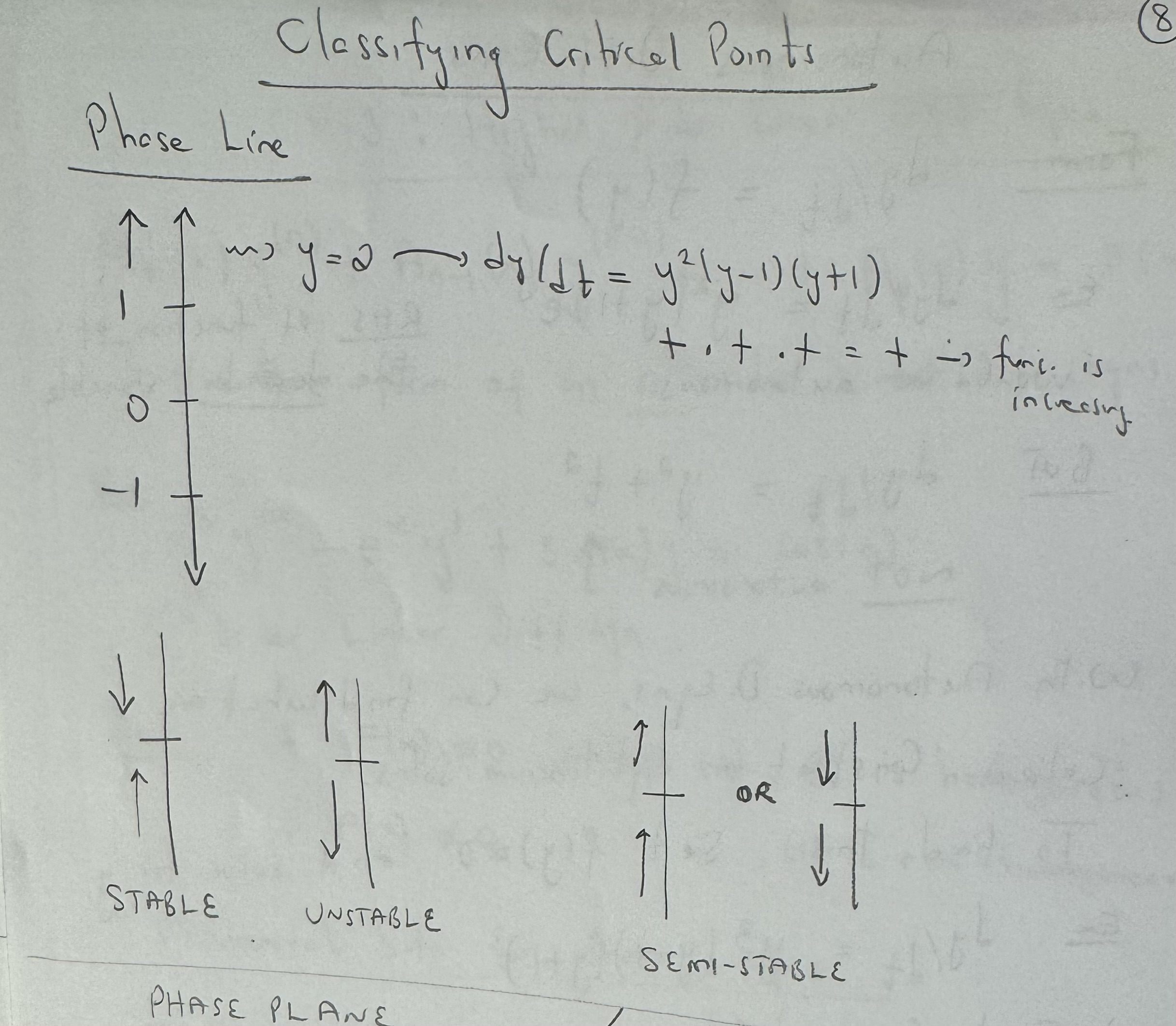Differential Equations Exam 1 Concepts
1/14
Earn XP
Description and Tags
Purdue 266
Name | Mastery | Learn | Test | Matching | Spaced |
|---|
No study sessions yet.
15 Terms
First Order: Separable
Form: dy/dx = f(x) * g(y)
separate so x are on one side and y is on other, integrate and solve for y in terms of x
First Order: Linear
Form: A(x)y’ + B(x)y= C(x)
Method used: Integrating Factor Method
normalize (y’+P(x)y=Q(x)), get y’ by itself, so divide by its coefficient
mu = e^(S P(x), mu is called the integrating factor
mu y = S mu Q(x) + C
solve for y
First Order: Exact Differential Equations
Form: M(x,y)dx + N(x,y) dy = 0
Test for exactness, My = Nx, so do a partial derivative of M with respect to y and N with respect to x
General solution for an exact equation is in the form F(x,y) = C
To find this do: Fx = M and Fy = N, integrate this
Assemble F by adding the DISTINCT terms from the integration step, so if there are two that are alike don’t add twice just put in once.
First Order: Bernoulli (Almost Linear)
Form: A(x)y’ + B(x)y= C(x)y^n n doesn’t equal 1,0
To solve:
Normalize, get the y’ to have coefficient of 1,
Then divide by y^n, and set v = the y component from B(x)y, to “fix” and make linear, then follow first order linear equation to solve and at the end replace back y for v, and solve for y by getting rid of any exponents.
First Order: Homogeneous (Almost separable)
Form: dy/dx=f(x,y)/g(x,y) Degree of each term is the same
make sure each term has same degree, if there is xy that is degree two since x has degree 1 and y has degree 1 and they are being mutliplied
divide each term by x^degree (ind.variable)
substitution: v = y/x ←— always this
then solve like separable.
Reducible 2nd Order: Independent variable is visible
A(x)y’’ = y’ is an example
a substitution would be: y’ = v, y’’ = v’ —> v’ = dv/dx, v is a function of x
then separate so that v and x are isolated on different sides of the equation
integrate to solve for v and then put back in y for v and finish solving for y
Reducible 2nd Order: Independent variable is invisible
A(y)y’’ = y’
Idea: let y be our new independent variable y will play role of x.
dy/dx=y’=v, derivative, y’’ = dv/dx * dv.dy dy/dx = dv/dy v
use this as your substitution, and solve
Application of First Order : Mixing Problem
What would be given:
rin = rate of solution in
cin = concentration of salt in
vo = initial volume of water in
yo = initial amount of salt in
rout = rate of solution out
y(t) = amount of salt in tank at time t
goal: find y(t)
iDEA: rate of change of salt tank = rate of salt (in - out)
dy/dt = rin*cin - rout*cout
cout = y/vo +(rin-rout)t : amount of salt in / vol of water in tank
so put together:
dy/dt = rin*cin - rout * (y/ vo+(rin-rout)t)
Euler’s Method ( Method to approximate a solution)
Given: y’ = f(x,y) ; y(xo)=yo ; h = step size
asked to estimate/approximate y(x)
y_n+1 = y_n + h * f(x_n, y_n)
Autonomous Diff Equation
Form: dy/dt = f(y)
We can find what are call constant or equilibrium solutions, to find this do:
set f(y) =0 and solve for y
y = some constants, and those are called the critical points.
Classifying Autonomous critical points
draw a graph, have the critical points be horizontal lines on the graph, and then find the slope fields of values above and below this line to indicate whether or not the graph is pointing towards or away from the horizontal line, if above and below the line are both pointing towards it, then it is a stable critical point, if both are pointing away, than it is unstable, and if one is point towards and one away, than it is a semi stable critical point.
determine the slope field by plugging in a value for y in the dy/dt equation and that positive or negative sign will dictate the direction.

Higher Order Linear diff equs
Form of an nth order linear diff equ:
A_n(x)y^n+A_n-1(x)*y^(n-1) + …+ A_o(x)y= F(x)
If F(x) = = 0 than the equation is homogeneous
if it is no equal to zero it is non-homogeneous
General solution for Higher Order Linear diff equs
Case 1: Distinct, real roots
First: ay’’+by’+cy=0, a,b,c are constants
ar² + br +c = 0 : characteristic equation, find the roots
r = j,k, whatever
y= C_1e^(r1x) + C_2e^(r2x)
General solution for Higher Order Linear diff equs
Case 2: Repeated real roots, r
First: ay’’+by’+cy=0, a,b,c are constants
ar² + br +c = 0 : characteristic equation, find the roots
r = +- k
y= C_1e^(rx) + C_2xe^(rx)
General solution for Higher Order Linear diff equs
Case 2: Complex roots r = a+- b i
First: ay’’+by’+cy=0, a,b,c are constants
ar² + br +c = 0 : characteristic equation, find the roots
prob use quadratic formula to find r and it will be
r = w +- k i
y = C_1e^(ax)*cos(kx) +C_2e^(ax)*sin(kx)